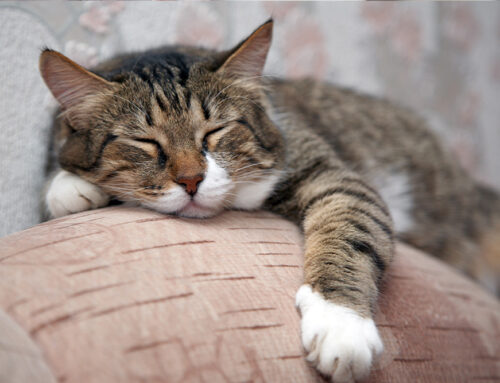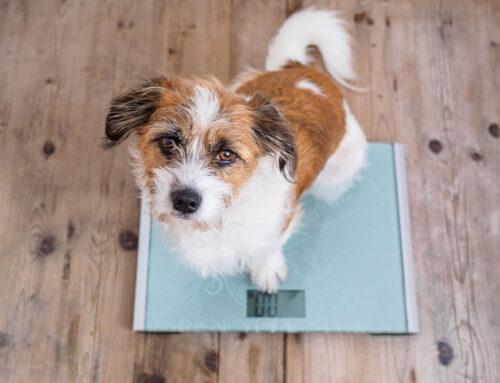Pet Obesity: Recognizing the Risks and Taking Action
A few extra pounds may seem harmless, but even small amounts of excess weight can quietly strain your pet’s heart, joints, and organs. Over time, obesity increases the risk of arthritis, diabetes, and heart disease and can shorten your pet’s lifespan by years.
At Central Kentucky Veterinary Center in Georgetown, KY, our AAHA-accredited team focuses on compassionate, quality-of-life-centered care using modern diagnostic tools. From body condition scoring to personalized nutrition counseling and rehabilitation, we help pets reach and maintain a healthy weight for a longer, more comfortable life.
Why Weight Management Matters
It’s hard to say no to those pleading eyes or the meow that sounds like a personal accusation. We know your cat yells at you when the food bowl is empty, and when your dog looks at you with sad eyes, it’s hard not to give in. But those extra treats can add up quickly, leading to more than just a few added pounds.
Weight influences far more than appearance. Obesity causes chronic inflammation, reduces energy, and puts stress on the heart, lungs, and joints. Keeping pets at a healthy weight helps them move comfortably, breathe easier, and enjoy life to the fullest.
We approach every pet’s weight journey as a partnership, offering guidance, encouragement, and tools that make healthy choices easier for both pets and their people. Our goal is steady, realistic progress- not perfection- because every healthy step forward makes a difference.
Beyond the Scale: Understanding Body Condition Scoring
The number on the scale doesn’t tell the full story. Two pets of the same breed and weight can have completely different body compositions depending on muscle tone and fat distribution.
Body Condition Scoring (BCS) gives a clearer picture by assessing visible contours and fat coverage through touch and observation. It’s the standard used in veterinary medicine to determine whether a pet is underweight, ideal, overweight, or obese.
The 9-Point BCS System
- 1–3: Too Thin – Ribs and spine visible, little muscle or fat.
- 4–5: Ideal – Ribs easily felt with a slight fat cover; visible waist and abdominal tuck.
- 6–7: Overweight – Ribs difficult to feel; waist less defined, body rounded.
- 8–9: Obese – No visible waist, heavy fat deposits over ribs, spine, and tail base.
This simple evaluation helps detect unhealthy trends early. At each wellness visit, we assess BCS alongside weight to create a personalized care plan.
Health Risks of Excess Weight
Carrying extra pounds affects nearly every system in your pet’s body.
Musculoskeletal Problems
Obesity puts pressure on joints, accelerating wear and tear. Conditions like arthritis and ligament tears become more likely, and recovery from injury takes longer.
Metabolic and Endocrine Disorders
Obesity is a leading risk factor for diabetes mellitus and hypothyroidism. These conditions alter metabolism and make weight control even more difficult.
Cardiovascular and Respiratory Issues
Excess fat tissue reduces lung expansion and forces the heart to work harder. Overweight pets tire easily and are at higher risk for heart disease and high blood pressure.
Heat Intolerance and Reduced Longevity
Extra insulation makes it harder for pets to regulate temperature, especially during Kentucky’s warm summers. Overweight pets, especially in brachycephalic breeds, are at a higher risk for heatstroke.
Keeping a lean figure isn’t only for looks! Studies show that lean pets can live nearly two years longer than their overweight counterparts.
Checking Your Pet’s Body Condition at Home
You don’t need special equipment to keep tabs on your pet’s condition between visits. Regular hands-on assessments help you notice subtle changes.
- Ribs: Run your hands over your pet’s ribs. You should feel them easily without pressing hard.
- Waist: Viewed from above, there should be a visible inward curve behind the ribs.
- Tummy tuck: Viewed from the side, the belly should slope upward toward the hind legs, not hang straight down.
For an easy comparison, feel the back of your hand. If your pet’s ribs feel like your knuckles, they may be too thin. If they feel like the palm of your hand, there’s too much fat covering them.
If you’re unsure about your findings, bring your pet in for a quick weight check. Our technicians are happy to assess your pet’s body condition and provide guidance.
Creating a Safe Weight Management Plan
Creating a healthy weight management plan is one of the most impactful ways to support your pet’s long-term health. The steps below focus on making safe, gradual changes tailored to your pet’s unique needs, activity level, and overall lifestyle.
Step 1: Find the Right Caloric Intake
Feeding guides on pet food labels often overestimate how much your pet needs. Using the Pet Calorie Calculator helps determine appropriate daily calories based on species, age, and activity level.
Our veterinarians use this information, combined with nutritional consulting, to recommend a feeding plan that fits your pet’s metabolism and lifestyle.
Step 2: Transition Slowly
Gradual changes prevent hunger and digestive upset. We adjust food portions, meal frequency, and treat limits step by step. For cats, weight loss must be especially slow to avoid hepatic lipidosis, a potentially life-threatening liver condition.
Step 3: Encourage Movement
Exercise burns calories and builds muscle that supports the joints. Our canine rehabilitation and physical therapy programs, such as underwater treadmill sessions and therapeutic laser therapy, help pets regain fitness safely, even when arthritis or old injuries limit mobility.
Step 4: Track Progress
Regular weigh-ins and BCS evaluations keep your pet’s plan on course. We celebrate every improvement and modify as needed to maintain healthy momentum.
Helping Pets Stay Active and Fit
Exercise keeps pets mentally sharp, physically strong, and full of energy. It’s also one of the best ways to strengthen the bond you share. Whether it’s daily walks, backyard play, or interactive toys, keeping your pet moving helps maintain mobility and a healthy metabolism.
For Dogs
Structured dog exercise programs use a mix of walking, play, and low-impact activities like swimming to build endurance and burn calories safely. Regular routines prevent stiffness, support healthy joints, and make fitness part of your dog’s everyday life.
For Cats
Helping cats exercise starts with finding ways to make movement part of their natural routine. Short, frequent play sessions with toys that mimic prey- like feather wands or laser pointers- encourage healthy bursts of activity. Food puzzles and vertical climbing spaces also add mental and physical stimulation. Even a few minutes of active play each day helps improve muscle tone, prevent stiffness, and keep cats engaged and agile.
Small, consistent steps add up- exercise doesn’t need to be extreme to be effective. The goal is steady progress and daily engagement that keeps tails wagging and paws moving.
Addressing Misconceptions About Pet Weight
“He’s Not Fat, He’s Big-Boned.”
Breed differences exist, but most pets with no visible waist or palpable ribs are overweight. Even “stocky” breeds like Bulldogs and Mastiffs benefit from a leaner physique.
“She Hardly Eats!”
Metabolism varies widely. Some pets require fewer calories than others, particularly as they age. Even small treats add up quickly. A single biscuit can equal an entire meal’s worth of calories for a small dog.
“A Little Chubbiness Means She’s Healthy.”
Extra fat doesn’t indicate good nutrition. In fact, obesity masks malnutrition by supplying calories but not essential nutrients.

Partnering for a Healthier Future
At Central Kentucky Veterinary Center, we believe in modern medicine delivered with empathy and partnership. Healthy weight management is a lifelong commitment, but you don’t have to do it alone. We combine nutritional guidance, rehabilitation, and modern tools to help pets thrive without stress or guilt. Pet obesity is one of the most common and most preventable health issues we see, and addressing it early leads to happier, more active years with the animals you love.
Our extended evening and weekend appointments make it easy to fit wellness care into your schedule. Whether you’re starting a new weight-loss plan or maintaining progress, we’re here to guide and encourage you every step of the way. If you’ve noticed changes in your pet’s weight or energy level, request an appointment or contact us. Together, we’ll create a personalized plan focused on comfort, confidence, and long-term well-being.







Leave A Comment